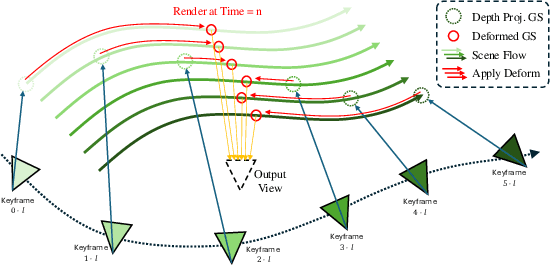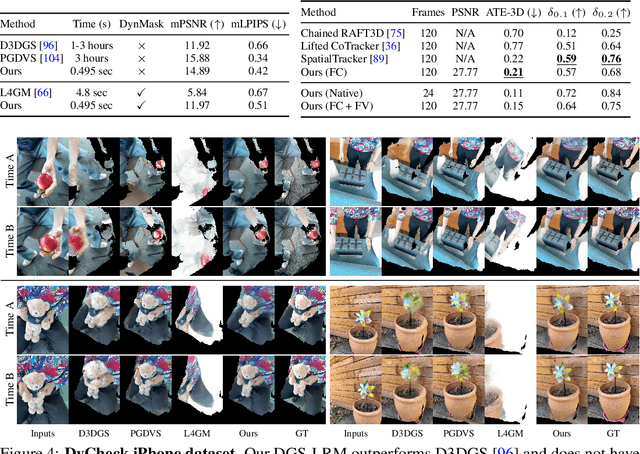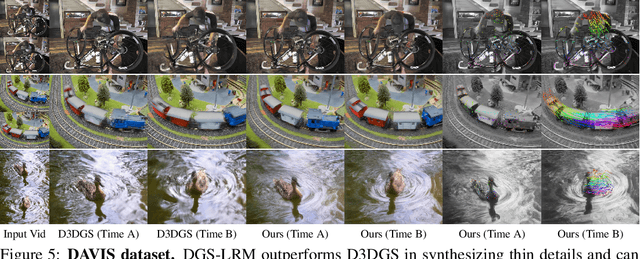Zhen Xu
EvHand-FPV: Efficient Event-Based 3D Hand Tracking from First-Person View
Sep 17, 2025Abstract:Hand tracking holds great promise for intuitive interaction paradigms, but frame-based methods often struggle to meet the requirements of accuracy, low latency, and energy efficiency, especially in resource-constrained settings such as Extended Reality (XR) devices. Event cameras provide $\mu$s-level temporal resolution at mW-level power by asynchronously sensing brightness changes. In this work, we present EvHand-FPV, a lightweight framework for egocentric First-Person-View 3D hand tracking from a single event camera. We construct an event-based FPV dataset that couples synthetic training data with 3D labels and real event data with 2D labels for evaluation to address the scarcity of egocentric benchmarks. EvHand-FPV also introduces a wrist-based region of interest (ROI) that localizes the hand region via geometric cues, combined with an end-to-end mapping strategy that embeds ROI offsets into the network to reduce computation without explicit reconstruction, and a multi-task learning strategy with an auxiliary geometric feature head that improves representations without test-time overhead. On our real FPV test set, EvHand-FPV improves 2D-AUCp from 0.77 to 0.85 while reducing parameters from 11.2M to 1.2M by 89% and FLOPs per inference from 1.648G to 0.185G by 89%. It also maintains a competitive 3D-AUCp of 0.84 on synthetic data. These results demonstrate accurate and efficient egocentric event-based hand tracking suitable for on-device XR applications. The dataset and code are available at https://github.com/zen5x5/EvHand-FPV.
Diffuman4D: 4D Consistent Human View Synthesis from Sparse-View Videos with Spatio-Temporal Diffusion Models
Jul 17, 2025Abstract:This paper addresses the challenge of high-fidelity view synthesis of humans with sparse-view videos as input. Previous methods solve the issue of insufficient observation by leveraging 4D diffusion models to generate videos at novel viewpoints. However, the generated videos from these models often lack spatio-temporal consistency, thus degrading view synthesis quality. In this paper, we propose a novel sliding iterative denoising process to enhance the spatio-temporal consistency of the 4D diffusion model. Specifically, we define a latent grid in which each latent encodes the image, camera pose, and human pose for a certain viewpoint and timestamp, then alternately denoising the latent grid along spatial and temporal dimensions with a sliding window, and finally decode the videos at target viewpoints from the corresponding denoised latents. Through the iterative sliding, information flows sufficiently across the latent grid, allowing the diffusion model to obtain a large receptive field and thus enhance the 4D consistency of the output, while making the GPU memory consumption affordable. The experiments on the DNA-Rendering and ActorsHQ datasets demonstrate that our method is able to synthesize high-quality and consistent novel-view videos and significantly outperforms the existing approaches. See our project page for interactive demos and video results: https://diffuman4d.github.io/ .
Towards Depth Foundation Model: Recent Trends in Vision-Based Depth Estimation
Jul 15, 2025Abstract:Depth estimation is a fundamental task in 3D computer vision, crucial for applications such as 3D reconstruction, free-viewpoint rendering, robotics, autonomous driving, and AR/VR technologies. Traditional methods relying on hardware sensors like LiDAR are often limited by high costs, low resolution, and environmental sensitivity, limiting their applicability in real-world scenarios. Recent advances in vision-based methods offer a promising alternative, yet they face challenges in generalization and stability due to either the low-capacity model architectures or the reliance on domain-specific and small-scale datasets. The emergence of scaling laws and foundation models in other domains has inspired the development of "depth foundation models": deep neural networks trained on large datasets with strong zero-shot generalization capabilities. This paper surveys the evolution of deep learning architectures and paradigms for depth estimation across the monocular, stereo, multi-view, and monocular video settings. We explore the potential of these models to address existing challenges and provide a comprehensive overview of large-scale datasets that can facilitate their development. By identifying key architectures and training strategies, we aim to highlight the path towards robust depth foundation models, offering insights into their future research and applications.
Enhancing Generalization of Spiking Neural Networks Through Temporal Regularization
Jun 24, 2025Abstract:Spiking Neural Networks (SNNs) have received widespread attention due to their event-driven and low-power characteristics, making them particularly effective for processing event-based neuromorphic data. Recent studies have shown that directly trained SNNs suffer from severe overfitting issues due to the limited scale of neuromorphic datasets and the gradient mismatching problem, which fundamentally constrain their generalization performance. In this paper, we propose a temporal regularization training (TRT) method by introducing a time-dependent regularization mechanism to enforce stronger constraints on early timesteps. We compare the performance of TRT with other state-of-the-art methods performance on datasets including CIFAR10/100, ImageNet100, DVS-CIFAR10, and N-Caltech101. To validate the effectiveness of TRT, we conducted ablation studies and analyses including loss landscape visualization and learning curve analysis, demonstrating that TRT can effectively mitigate overfitting and flatten the training loss landscape, thereby enhancing generalizability. Furthermore, we establish a theoretical interpretation of TRT's temporal regularization mechanism based on the results of Fisher information analysis. We analyze the temporal information dynamics inside SNNs by tracking Fisher information during the TRT training process, revealing the Temporal Information Concentration (TIC) phenomenon, where Fisher information progressively concentrates in early timesteps. The time-decaying regularization mechanism implemented in TRT effectively guides the network to learn robust features in early timesteps with rich information, thereby leading to significant improvements in model generalization. Code is available at https://github.com/ZBX05/Temporal-Regularization-Training.
DGS-LRM: Real-Time Deformable 3D Gaussian Reconstruction From Monocular Videos
Jun 11, 2025



Abstract:We introduce the Deformable Gaussian Splats Large Reconstruction Model (DGS-LRM), the first feed-forward method predicting deformable 3D Gaussian splats from a monocular posed video of any dynamic scene. Feed-forward scene reconstruction has gained significant attention for its ability to rapidly create digital replicas of real-world environments. However, most existing models are limited to static scenes and fail to reconstruct the motion of moving objects. Developing a feed-forward model for dynamic scene reconstruction poses significant challenges, including the scarcity of training data and the need for appropriate 3D representations and training paradigms. To address these challenges, we introduce several key technical contributions: an enhanced large-scale synthetic dataset with ground-truth multi-view videos and dense 3D scene flow supervision; a per-pixel deformable 3D Gaussian representation that is easy to learn, supports high-quality dynamic view synthesis, and enables long-range 3D tracking; and a large transformer network that achieves real-time, generalizable dynamic scene reconstruction. Extensive qualitative and quantitative experiments demonstrate that DGS-LRM achieves dynamic scene reconstruction quality comparable to optimization-based methods, while significantly outperforming the state-of-the-art predictive dynamic reconstruction method on real-world examples. Its predicted physically grounded 3D deformation is accurate and can readily adapt for long-range 3D tracking tasks, achieving performance on par with state-of-the-art monocular video 3D tracking methods.
4DGT: Learning a 4D Gaussian Transformer Using Real-World Monocular Videos
Jun 09, 2025Abstract:We propose 4DGT, a 4D Gaussian-based Transformer model for dynamic scene reconstruction, trained entirely on real-world monocular posed videos. Using 4D Gaussian as an inductive bias, 4DGT unifies static and dynamic components, enabling the modeling of complex, time-varying environments with varying object lifespans. We proposed a novel density control strategy in training, which enables our 4DGT to handle longer space-time input and remain efficient rendering at runtime. Our model processes 64 consecutive posed frames in a rolling-window fashion, predicting consistent 4D Gaussians in the scene. Unlike optimization-based methods, 4DGT performs purely feed-forward inference, reducing reconstruction time from hours to seconds and scaling effectively to long video sequences. Trained only on large-scale monocular posed video datasets, 4DGT can outperform prior Gaussian-based networks significantly in real-world videos and achieve on-par accuracy with optimization-based methods on cross-domain videos. Project page: https://4dgt.github.io
FreeTimeGS: Free Gaussian Primitives at Anytime and Anywhere for Dynamic Scene Reconstruction
Jun 06, 2025



Abstract:This paper addresses the challenge of reconstructing dynamic 3D scenes with complex motions. Some recent works define 3D Gaussian primitives in the canonical space and use deformation fields to map canonical primitives to observation spaces, achieving real-time dynamic view synthesis. However, these methods often struggle to handle scenes with complex motions due to the difficulty of optimizing deformation fields. To overcome this problem, we propose FreeTimeGS, a novel 4D representation that allows Gaussian primitives to appear at arbitrary time and locations. In contrast to canonical Gaussian primitives, our representation possesses the strong flexibility, thus improving the ability to model dynamic 3D scenes. In addition, we endow each Gaussian primitive with an motion function, allowing it to move to neighboring regions over time, which reduces the temporal redundancy. Experiments results on several datasets show that the rendering quality of our method outperforms recent methods by a large margin. Project page: https://zju3dv.github.io/freetimegs/ .
Event-Based Eye Tracking. 2025 Event-based Vision Workshop
Apr 25, 2025Abstract:This survey serves as a review for the 2025 Event-Based Eye Tracking Challenge organized as part of the 2025 CVPR event-based vision workshop. This challenge focuses on the task of predicting the pupil center by processing event camera recorded eye movement. We review and summarize the innovative methods from teams rank the top in the challenge to advance future event-based eye tracking research. In each method, accuracy, model size, and number of operations are reported. In this survey, we also discuss event-based eye tracking from the perspective of hardware design.
Application of Deep Generative Models for Anomaly Detection in Complex Financial Transactions
Apr 21, 2025Abstract:This study proposes an algorithm for detecting suspicious behaviors in large payment flows based on deep generative models. By combining Generative Adversarial Networks (GAN) and Variational Autoencoders (VAE), the algorithm is designed to detect abnormal behaviors in financial transactions. First, the GAN is used to generate simulated data that approximates normal payment flows. The discriminator identifies anomalous patterns in transactions, enabling the detection of potential fraud and money laundering behaviors. Second, a VAE is introduced to model the latent distribution of payment flows, ensuring that the generated data more closely resembles real transaction features, thus improving the model's detection accuracy. The method optimizes the generative capabilities of both GAN and VAE, ensuring that the model can effectively capture suspicious behaviors even in sparse data conditions. Experimental results show that the proposed method significantly outperforms traditional machine learning algorithms and other deep learning models across various evaluation metrics, especially in detecting rare fraudulent behaviors. Furthermore, this study provides a detailed comparison of performance in recognizing different transaction patterns (such as normal, money laundering, and fraud) in large payment flows, validating the advantages of generative models in handling complex financial data.
LLM-Sketch: Enhancing Network Sketches with LLM
Feb 11, 2025Abstract:Network stream mining is fundamental to many network operations. Sketches, as compact data structures that offer low memory overhead with bounded accuracy, have emerged as a promising solution for network stream mining. Recent studies attempt to optimize sketches using machine learning; however, these approaches face the challenges of lacking adaptivity to dynamic networks and incurring high training costs. In this paper, we propose LLM-Sketch, based on the insight that fields beyond the flow IDs in packet headers can also help infer flow sizes. By using a two-tier data structure and separately recording large and small flows, LLM-Sketch improves accuracy while minimizing memory usage. Furthermore, it leverages fine-tuned large language models (LLMs) to reliably estimate flow sizes. We evaluate LLM-Sketch on three representative tasks, and the results demonstrate that LLM-Sketch outperforms state-of-the-art methods by achieving a $7.5\times$ accuracy improvement.
 Add to Chrome
Add to Chrome Add to Firefox
Add to Firefox Add to Edge
Add to Edge